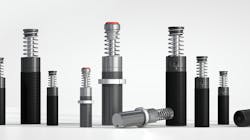The Basics of Shock Absorbers
Tip 1: Always take the specific needs of your application into account.
With a wide variety of uses, shock absorbers find themselves in a lot of different types of environments from temperature and humidity extremes to exposure to saltwater and other corrosive chemicals. Load capabilities can vary from only a few pounds to thousands of pounds. Before you begin your selection process, consider the needs of the application and the effects a shock absorber might have on reducing wear and tear on your machine, reducing noise for employee safety reasons, and increasing the life expectancy of your machine.
Tip 2: Understand what makes shock absorbers different than other devices used to absorb shock.
There are other products on the market to absorb shocks and they all have a place, but they don’t all offer the same value as the properly specified shock absorber. For example, industrial hydraulic dashpots offer only a single metering orifice resulting in a harder hit upon impact; springs and rubber bumpers provide a hard set-down with a high recoil potential; and cylinder cushions only allow a hard set-down. Shock absorbers, on the other hand, provide a linear deceleration, with constant force in the shortest amount of time—and without force peaks (see Figure 1). Figure 1: Shock absorbers provide a linear deceleration of the load with a constant force in the shortest amount of time.
Tip 3: Consider how shock absorbers decelerate moving loads without damaging impacts.
Shock absorbers are used to increase productivity by decelerating moving loads without the damaging impacts that are prevalent when shock absorbers are not present. Because the kinetic energy of motion exerted on a shock absorber is quickly turned into heat, potentially damaging loads are decelerated to the point where they put less stress on the machine. This means that the machine is able to operate faster without the possibility of damage, which produces, for the user, a more durable machine that can deliver a more competitive and profitable outcome.
Tip 4: Become familiar with how shock absorbers work.
Shock absorbers provide deceleration by forcing oil from a high-pressure tube through an orifice to a low-pressure area. At this point, the oil forced through orifices from the high-pressure tube is stored by compressing an accumulator in the low-pressure area. As many shock absorbers are self-contained hydraulic components, they are fully sealed and maintenance-free, which reduces construction as well as repair costs. Shock absorbers are offered in short overall lengths and with low return forces when sized properly for your specific application. Care should be taken for customers to always ensure that the shock has been properly specified for the application to assure the right fit and function.
Tip 5: Know the major benefits of using shock absorbers.
System performance and longevity are the major benefits. These are due to the ability to increase operational speeds without damaging your equipment and by allowing for an increase in operating loads while also reducing stress on the machine. These capabilities will make equipment more reliable over the long haul. Additional benefits include reducing noise levels and operational energy costs. By properly specifying your shock absorber you can often reduce the actuator cylinder size, which reduces design and fabrication costs.
Tip 6: Don’t underestimate where a shock absorber might add value to your operation.
Shock absorbers are available from 5 mm to up to 5-in. diameter units, which means they can work with small and large loads. Machines are designed and manufactured for a specific need and protecting them from shock and vibration is key to long life. In addition, because of their closed system construction, shock absorbers are available for use in literally every industry from marine to aerospace and from semiconductor to industrial manufacturing.
Tip 7: Work with a company that has experience and expertise in a wide variety of applications.
Working with the right company might mean that you evaluate the size of their portfolio, whether they have application engineers to help you calculate your exact needs, and if they offer customer support that includes one-on-one assistance. You’ll want to select a company with a global network of technical, engineering-focused distributors as well. Another benefit is the availability of a wide variety of online help materials. For example, ACE Controls provides online sizing and configuration tools as well as a technical blog with case studies, wh
